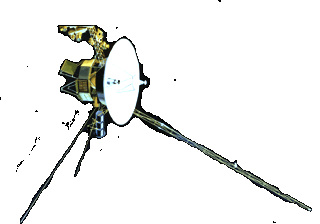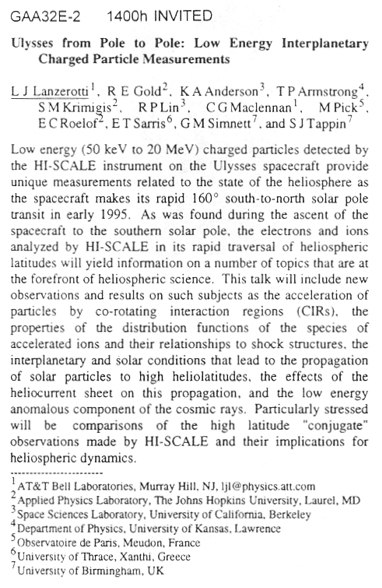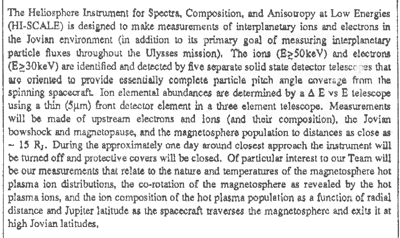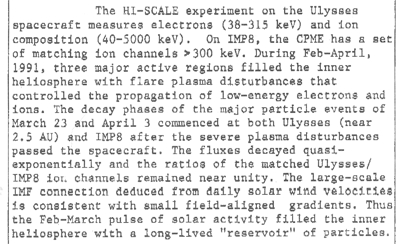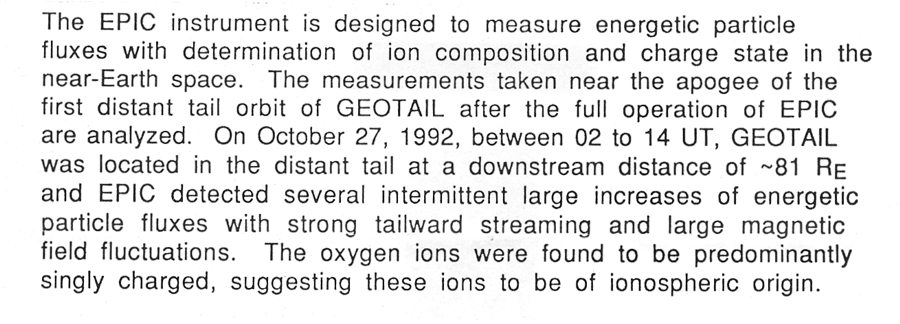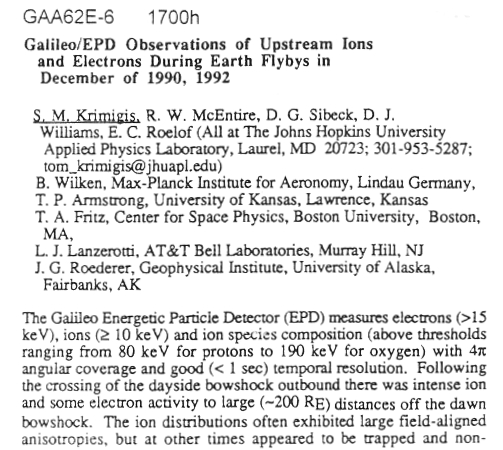Thomas P. Armstrong - Non-AGU Meeting Abstracts
L. J. Lanzerotti, R. E. Gold, K. A. Anderson, T. P. Armstrong, S. M. Krimigis, R. P. Lin, C. G. Maclennan, M. Pick, E. C. Roelof, E. T. Sarris, G. M. Simnett, and S. J. Tappin, Ulysses from Pole to Pole: Low Energy Interplanetary Charged Particle Measurements (INVITED), 1995 IUGG Meeting, Boulder, CO, 1995. Abstract:
|
|
D. J. Williams, R. W. McEntire, S. M. Krimigis, E. C. Roelof, B. Wilken, T. P. Armstrong, T. A. Fritz, L. J. Lanzerotti, and J. G. Roederer, The Galileo Energetic Particles Detector (EPD): First Observations at Jupiter, 1996 COSPAR Meeting, Birmingham, England. Abstract:
|
The Galileo Energetic Particles Detector (EPD) instrument contains two bi-directional telescopes mounted on an integral stepping platform. Magnetic deflection, ΔE vs. E, and time-of-flight techniques are used to measure spectral and 3-dimensional angular distributions for electrons (>15 keV) and for ions (>20 keV), with ion species composition above thresholds ranging from 80 keV for protons to 190 keV for oxygen. We will briefly describe the EPD and its planned operations during the Galileo mission. On the Galileo approach trajectory on December 7, 1995, two hours of full-resolution EPD data were recorded, inbound from 7.8 RJ to 5.4 RJ, covering a major part of the Io plasma torus. We will present and discuss preliminary observations by EPD of the energetic particle environment in the Io torus. |
D. Lario, R. B. Decker, and T.
P. Armstrong, Major Solar Proton
Events observed by IMP-8 (from November 1973 to
May 2001), Proceedings of ICRC 2001, pp. 1-4, 2001.
Abstract:
|
The unprecedented long and still ongoing mission of the IMP-8 spacecraft has generated a uniform and nearly time-continuous database of energetic particle events for the last two solar cycles and the rising phase of solar cycle 23. In this paper we use energetic proton (0.3-440 MeV) intensities from the CPME instrument in order to select the major solar energetic proton (SEP) events observed during this long-term period (Nov. 1973 - March 2001). We examine their time-intensity profiles and their temporal distribution within the sunspot solar cycles. We compare the two recent large SEP events observed so far in solar cycle 23 (i.e., the Bastille Day 2000 event and the Nov. 9, 2000, event) with the other major SEP events observed over the last two solar cycles. These two events show by far the most intense SEP fluxes ever observed by IMP-8. The study of these observations will help us to determine how intense a SEP event can be. |
L. J. Lanzerotti, R. E. Gold, E. C. Roelof, G. M. Simnett, K. A. Anderson, T. P. Armstrong, R. P. Lin, S. M. Krimigis, M. Pick, and E. T. Sarris, Low Energy Ion and Electron Measurements at Jupiter by the Hi-Scale Instrument on Ulysses, COSPAR Meeting (INVITED), Symposium D.1-S, Washington, DC, 1992. Abstract:
|
|
E. C. Roelof, G. M. Simnett, T. P. Armstrong, R. E. Gold, and L. J. Lanzerotti, The Decay Phase of the March-April, 1991 Low-Energy Particle Events Observed at Ulysses and Earth, COSPAR Meeting, Symposium D.2-5, Washington, DC, 1992. Abstract:
|
|
D. J. Williams, T. P. Armstrong, S. P. Christon, G. Gloeckler, R. E. Gold, S. M. Krimigis, A. T. Y. Lui, R. W. McEntire, C.-I. Meng, E. C. Roelof, L. J. Lanzerotti, E. T. Sarris, D. H. Fairfield, and S. Kokubun, Initial Investigation of the Distant Tail From EPIC, IAGA 1993 Meeting, Session 3.12. Abstract:
|
|
S. M. Krimigis, R. W. McEntire, D. G. Sibeck, D. J. Williams, E. C. Roelof, B. Wilken, T. P. Armstrong, T. A. Fritz, L. J. Lanzerotti, and J. G. Roederer, Galileo/EPD Observations of Upstream Ions and Electrons During Earth Flybys in December of 1990, 1992, 1995 IUGG Meeting, Boulder, CO, 1995. Abstract:
Return to Fundamental Technologies Home Page.
Updated 03/11/2019
Cameron Crane
RELATED LINKS
(relatedContent)